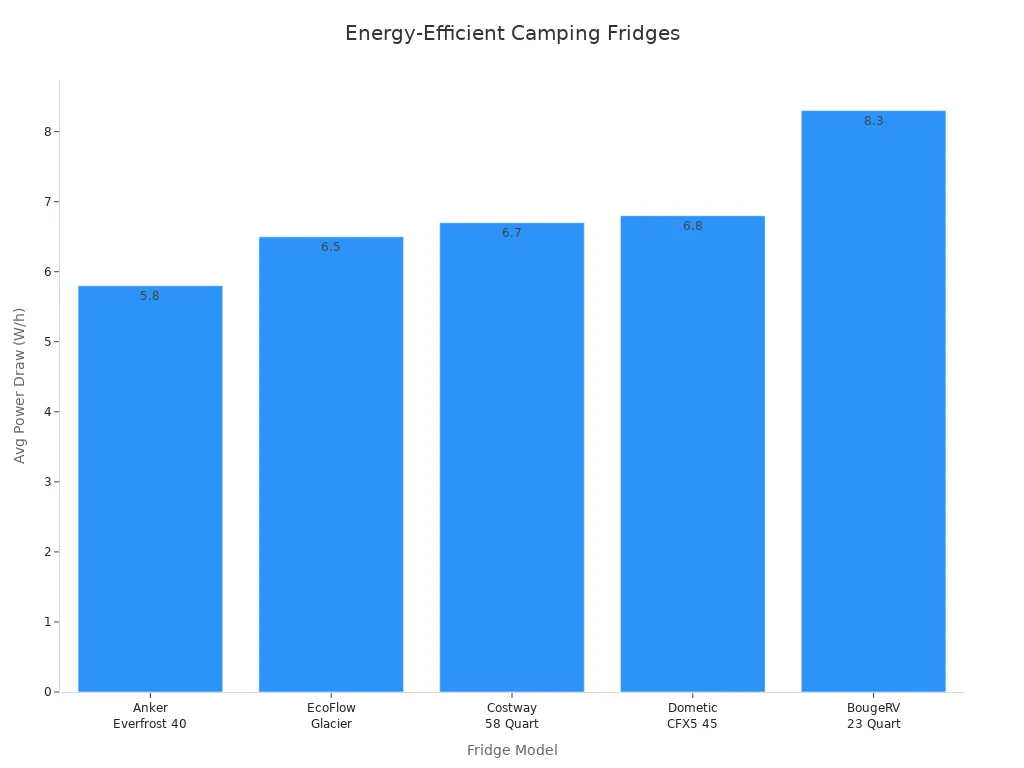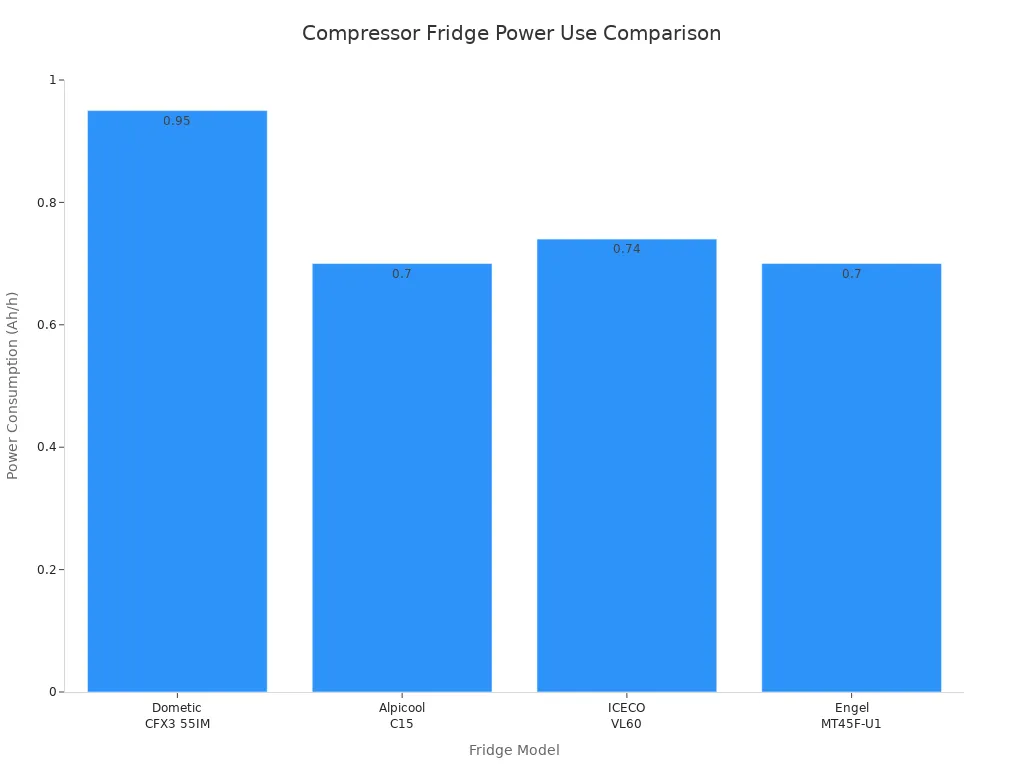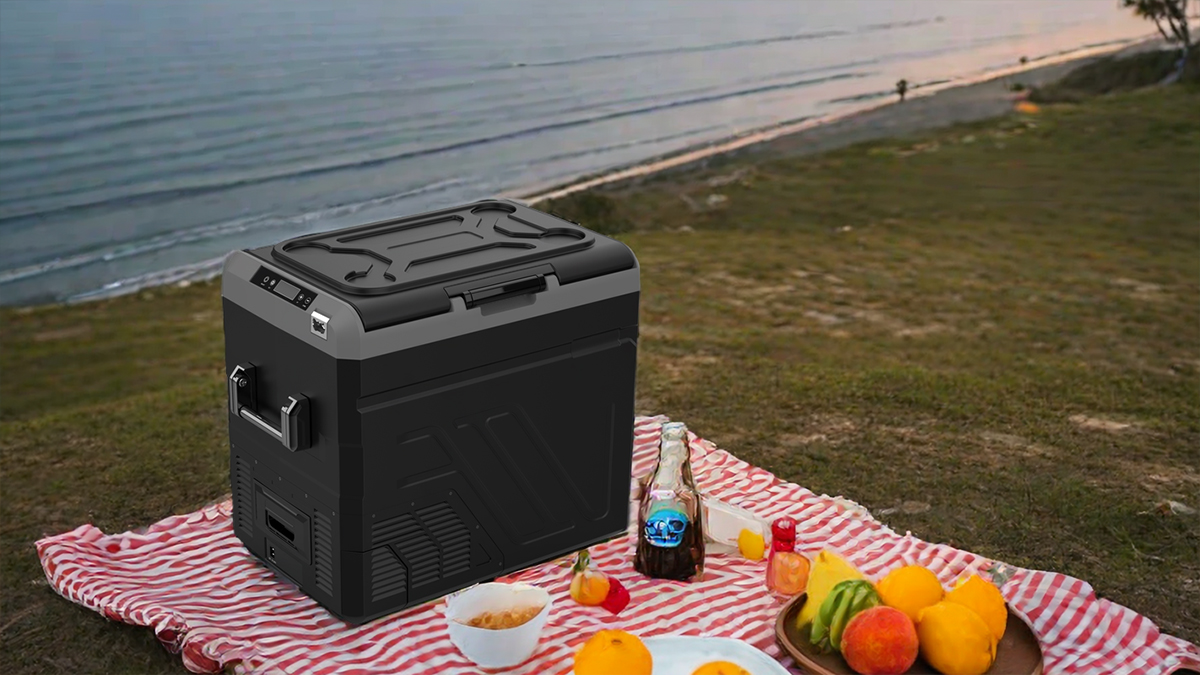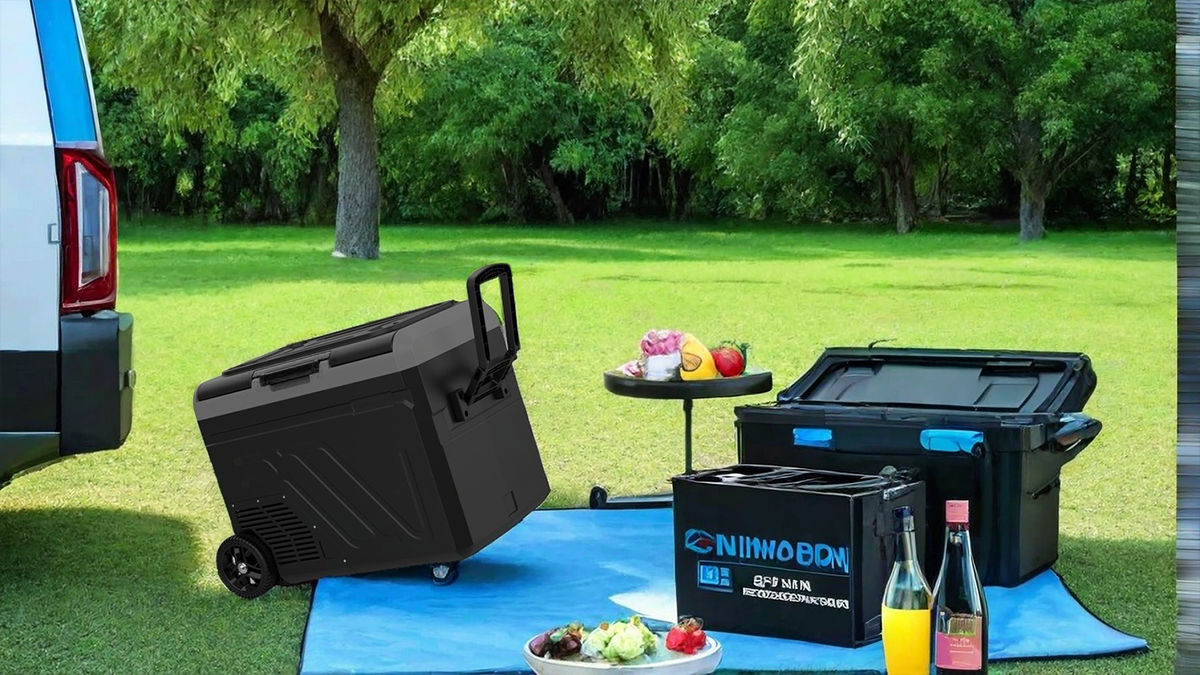Is your compressor fridge ready for rugged outdoor adventures? For a car refrigerator freezer compressor fridge for outdoor camping dual temperature, experts recommend checking these essentials:
- Reliable compressor cooling for long trips
- Dual-zone fridge and freezer options
- Multiple power sources, including solar
- Durable, quiet, and portable design
Preparation ensures optimal performance, food safety, and peace of mind. A dependable outdoor refrigerator keeps meals fresh, while a camping fridge or car freezer supports every journey.
Readiness Criteria for Outdoor Use
Reliable Cooling Performance
Outdoor adventures demand a compressor fridge that delivers consistent cooling, even in changing weather. Industry leaders design compressor fridges with powerful systems that maintain precise temperatures. The Alpicool R50 sets a benchmark by offering dual-zone cooling and versatile power sources, ensuring food stays fresh and safe. Modern compressor fridges use advanced components like compressors, condenser coils, and evaporator fans. These parts work together to circulate refrigerant and distribute cold air evenly. When temperatures rise, the compressor increases its activity to keep the interior cool. Regular cleaning of condenser coils and proper ventilation help maintain efficiency.
Tip: Adjust the fridge settings to match outdoor conditions and keep ventilation openings clear for optimal cooling.
Compressor-driven fridges outperform thermoelectric coolers by maintaining accurate temperatures in both hot and cold climates. Features such as dual-zone functionality and multi-voltage compatibility (12/24V DC and 110/220V AC) reflect the industry’s focus on reliability and convenience for outdoor use.
Dual Temperature Functionality
Dual temperature zones provide flexibility for campers. A car refrigerator freezer compressor fridge for outdoor camping dual temperature allows users to store frozen items in one compartment and chilled foods in another. This design supports food safety by preventing spoilage and keeping different types of food at their ideal temperatures. For example, the BougeRV CRX2 offers independent controls for each compartment, ranging from -4°F to 50°F. Campers can store ice cream, fresh produce, and beverages all in one unit.
- Independent control of freezing and cooling areas
- Fast cooling capability for quick preservation
- Energy-saving modes (MAX and ECO)
- Silent operation for a peaceful environment
- Smart battery protection for safe travel
Dual temperature functionality increases storage flexibility and supports longer trips. Built-in battery protection and LED touch panels add convenience and safety.
Sufficient Storage Capacity
Choosing the right storage capacity is essential for successful camping. A 50-liter compressor fridge suits families or small groups, providing enough space for weekend or week-long trips. Insufficient capacity can lead to food spoilage, attract wildlife, and complicate trip planning. Campers should assess meal numbers and portion sizes before packing.
| Number of People / Trip Duration | Recommended Fridge Capacity (Liters) |
|---|---|
| 1-2 people | 20-40 |
| 3-4 people | 40-60 |
| 5+ people | 60+ |
| Weekend trips | 20-40 |
| 1-week trips | 40-60 |
| 2+ week trips | 60+ |
| Family of 4 on weekend trips | 40-60 |
| Extended trips or RV living | 60-90 minimum |
| Groups of 6+ or freezer needs | 90+ |
Note: Use sturdy, airtight containers and plan meals to consume fresh ingredients early. This strategy helps optimize limited storage space and maintain food safety.
Energy Efficiency and Power Options
Energy efficiency matters for campers who rely on vehicle batteries or solar panels. The most efficient compressor fridges operate on 12V DC, drawing minimal power while keeping food fresh. Models like the Anker Everfrost 40 and EcoFlow Glacier feature built-in batteries and multiple energy-saving modes. These fridges can run unplugged for extended periods, making them ideal for off-grid adventures.

Compressor fridges support various power sources, including dual DC inputs (12V/24V) and AC power (110-240V). This versatility allows campers to switch between vehicle batteries and campsite outlets. Durable insulation and insulated covers further improve power efficiency. Compared to absorption fridges, compressor models offer faster cooling, lower energy consumption, and easier installation.
| Feature | Compressor Fridges (12V DC) | Absorption Fridges (Gas, 12V, 230V AC) |
|---|---|---|
| Power Sources | 12V/24V DC, 110-240V AC | Gas, 12V DC, 230V AC |
| Energy Efficiency | Lower power consumption, fast cooling | Higher energy use, best in moderate climates |
| Cooling Performance | Reliable in hot/cold climates | Needs ventilation, best in moderate temperatures |
| Installation | Easy, no gas or ventilation needed | Requires ventilation and gas supply |
| Noise Level | Quiet, some silent modes | Silent operation |
| Off-grid Use | Pair with batteries/solar panels | Can run on gas without batteries |
| Tilt Sensitivity | Operates at any angle | Must stay level (less than 2.5° tilt) |
A car refrigerator freezer compressor fridge for outdoor camping dual temperature combines energy efficiency, flexible power options, and robust cooling performance. These features ensure reliable operation and peace of mind during any outdoor adventure.
Key Features to Check Before Your Trip
Temperature Range and Control
A compressor fridge must maintain the right temperature to keep food safe during outdoor adventures. The ideal range for perishable foods sits between 32°F (0°C) and 40°F (4°C). Freezer compartments should stay at or below 0°F (-17.8°C) to prevent freezer burn and preserve quality. Campers can follow these tips for best results:
- Pre-cool the fridge and food before loading.
- Avoid overpacking to allow airflow.
- Place the fridge in a shaded, ventilated spot.
- Use a cover for extra insulation.
- Set the temperature around 36°F (2°C) for most foods.
- Limit door openings to reduce temperature swings.
These steps help keep food fresh and the fridge running efficiently.
Noise Level During Operation
Noise can affect the camping experience, especially at night. Most leading compressor fridges operate between 35 and 45 decibels, similar to a quiet office or library. This low noise level supports campground quiet hours and helps everyone sleep well. Excessive noise can disturb campers and wildlife, so choosing a fridge with quiet operation is important for a peaceful environment.
Durability and Build Quality
Outdoor use demands strong construction. Many compressor fridges use stainless steel parts and reinforced doors to handle rough conditions. Good insulation keeps temperatures steady and reduces compressor strain. Moisture-resistant materials and robust insulation protect against dust, moisture, and vibration. Regular cleaning and maintenance further extend the fridge’s lifespan.
Proper Ventilation and Heat Dissipation
Proper ventilation ensures the fridge works efficiently and lasts longer. Campers should leave at least 2-3 inches of space around the fridge for airflow. Vents and coils must stay clean and clear of obstructions. Placing the fridge in open, well-ventilated areas prevents overheating, reduces energy use, and keeps food safe. Following manufacturer guidelines for installation and ventilation helps maintain top performance.
Essential Preparation Steps for Outdoor Camping
Pre-cooling the Compressor Fridge
Campers achieve better cooling performance by pre-cooling the compressor fridge before loading food. They turn on the fridge several hours or overnight before departure, allowing it to reach food-safe temperatures near 41°F. Placing frozen water jugs and cold drinks inside speeds up the cooling process. Setting the temperature slightly below the optimal range helps avoid frost and reduces compressor strain. Switching to Eco mode after cooling preserves battery life. Pre-cooling saves energy because the compressor does not need to work harder to chill warm items.
Tip: Use a thermometer with an external readout to monitor the fridge temperature during pre-cooling.
Smart Packing and Organization
Efficient packing maximizes storage and maintains food safety. Campers pre-chill all items before packing. They group similar foods together, such as meats at the bottom and dairy above. Transparent, labeled containers prevent spills and make items easy to find. Frequently used essentials stay at the front or top for quick access. Dividers or baskets help maintain airflow and prevent uneven cooling. Organizing by meal times streamlines preparation and reduces unnecessary rummaging.
| Packing Strategy | Benefit |
|---|---|
| Pre-chill items | Reduces fridge workload |
| Group similar foods | Maintains order |
| Use labeled containers | Prevents spills, speeds access |
| Keep essentials handy | Minimizes disturbance |
Ensuring Proper Airflow Inside and Out
Proper airflow supports efficient cooling. Campers avoid overpacking to keep air circulating around food. They maintain at least 3-4 inches of clearance around the fridge, allowing heat to escape and preventing overheating. Placing the fridge in a ventilated area, away from corners, ensures the condenser and fan operate efficiently.
Insulation and Sun Protection
High-quality insulation materials reduce heat transfer and stabilize cooling performance. UV-resistant coatings protect the fridge from sunlight-induced aging. Campers shield the fridge from direct sunlight to prevent overheating and excessive battery drain. Weather-resistant materials and efficient ventilation help maintain stable cooling, even in high outdoor temperatures.
Note: Using an insulated cover further improves efficiency and protects the fridge from environmental stressors.
Power Solutions for Car Refrigerator Freezer Compressor Fridge for Outdoor Camping Dual Temperature
Battery and Power Source Selection
Choosing the right battery and power source is essential for reliable fridge operation during outdoor trips. Compressor fridges work best with external lithium batteries, such as the ICECO Magnetic Power Bank. These batteries offer high capacity, multiple output types, and easy recharging from solar, car, or wall outlets. Their magnetic design allows users to attach them directly to the fridge or vehicle, saving space and adding convenience. For longer adventures, external lithium power banks with solar recharge capability provide the most flexibility and reliability. Fridges with built-in batteries are compact and simple, making them ideal for short trips.
- External lithium battery power banks support extended use.
- Multiple charging options (solar, car, wall) increase flexibility.
- Magnetic designs optimize space and convenience.
Solar Panel Compatibility
Modern compressor fridges, including many car refrigerator freezer compressor fridge for outdoor camping dual temperature models, now feature improved energy efficiency. This makes them highly compatible with solar panel systems. Advances in compressor technology, such as SECOP and Danfoss models, reduce energy use by up to 40%. Lithium iron phosphate (LiFePO4) batteries pair well with solar setups, offering fast charging and long life. Campers should ensure voltage compatibility (12V/24V DC) and use charge controllers for safe, efficient energy management.
| Model | Voltage Compatibility | Power Consumption (Ah/h) | Battery Protection System | Notes |
|---|---|---|---|---|
| Dometic CFX3 55IM | 12/24 V DC, 100-240 V AC | ~0.95 Ah/h | Three-stage | Large capacity, ice maker |
| Alpicool C15 | 12/24 V DC, 110-240 V AC | ~0.7 Ah/h | Three-level | Eco-mode for energy saving |
| ICECO VL60 | 12/24 V DC, 110-240 V AC | ~0.74 Ah/h | Four-level | Dual zone fridge/freezer |
| Engel MT45F-U1 | 12 V DC, AC | ~0.7 Ah/h | Low voltage cut-off | Durable swing motor compressor |

Managing Power Consumption on the Go
Managing power use helps campers get the most from their fridge and battery. The compressor cycles on and off, with a typical duty cycle between 33% and 45%. Hot weather can increase power needs by up to 20%. Campers should match their power station capacity to the fridge’s rating and confirm output compatibility, usually 12V DC. Solar recharging keeps the system running longer. Adjusting temperature settings, operating the fridge in intervals, and improving insulation all help conserve energy.
- Match power station capacity to fridge needs.
- Use solar recharging for sustainable power.
- Regulate temperature settings to save energy.
- Improve insulation to reduce compressor workload.
Must-Have Accessories for Outdoor Adventures
Insulated Covers and Protective Jackets
Insulated covers and protective jackets help maintain the internal temperature of a compressor fridge. These accessories reduce the impact of direct sunlight and harsh weather. They also protect the fridge from scratches and bumps during transport. Many outdoor enthusiasts choose covers with UV-resistant materials for extra durability. Using an insulated cover can lower energy consumption by keeping the fridge cooler for longer periods.
Tip: Select a cover that fits the fridge model snugly to maximize insulation and protection.
Tie-down Straps and Mounting Solutions
Tie-down straps and mounting solutions keep the fridge secure during travel. Rough roads and sudden stops can shift equipment inside a vehicle. Heavy-duty straps prevent the fridge from moving or tipping over. Some mounting kits include brackets that attach directly to the vehicle floor. This setup provides extra stability for off-road adventures.
- Heavy-duty straps offer strong support.
- Mounting brackets add extra safety.
Extra Baskets and Organizers
Extra baskets and organizers help users arrange food and drinks efficiently. Removable baskets allow for easy access to items at the bottom of the fridge. Organizers separate different types of food, reducing the risk of cross-contamination. Campers can plan meals better when everything stays in its place.
| Accessory | Benefit |
|---|---|
| Removable basket | Easy access to items |
| Divider | Keeps food organized |
Thermometers and Monitoring Tools
Thermometers and monitoring tools provide real-time temperature readings. These devices help users ensure food stays at safe temperatures. Digital thermometers with external displays allow for quick checks without opening the fridge. Some advanced models connect to smartphones for remote monitoring.
Note: Regular temperature checks help prevent food spoilage and ensure safe storage during any adventure.
Troubleshooting and Maintenance Tips
Common Issues and Quick Fixes
Compressor fridges can face several issues during outdoor adventures. Recognizing symptoms early helps campers act quickly and avoid food spoilage. The table below lists common problems, signs to watch for, and recommended solutions:
| Common Issue | Symptoms / Signs | Quick Fixes / Recommendations |
|---|---|---|
| Dirty Condenser Coils | Compressor runs constantly; fridge not cooling well | Clean dust and debris from coils and fan with a brush and vacuum |
| Failed Condenser or Evaporator Fan | Fridge not cooling; freezer cold but fridge warm | Check for obstructions; spin fan manually; replace motor if faulty |
| Defrost System Malfunction | Ice buildup on evaporator cover; frost-clogged coils | Enter defrost mode; inspect heater and control board; repair as needed |
| Faulty Capacitors | Compressor issues; fridge not cooling properly | Test and replace capacitor if needed |
| Refrigerant Leaks | Compressor runs non-stop; fridge not cooling | Contact a technician for inspection and possible refrigerant refill |
| Faulty Compressor | Loud compressor noise; fridge not cooling | Test and replace compressor if faulty |
| Incorrectly Loaded Fridge | Blocked vents; poor temperature regulation | Rearrange food to unblock vents and allow airflow |
| Incorrect Thermostat Setting | Fridge/freezer temperatures not correct | Adjust thermostat to recommended settings |
| Reset Power | Fridge unresponsive or malfunctioning | Unplug or switch off, wait five minutes, then restore power |
Tip: Regular checks and quick action can prevent most issues from affecting your trip.
Preventive Care for Longevity
Routine maintenance extends the life of a compressor fridge and ensures reliable performance outdoors. Campers should follow these steps:
- Clean cooling coils and fins regularly to remove dust and dirt.
- Inspect the compressor for leaks, oil stains, or unusual noises.
- Check door seals for wear or gaps and replace if needed.
- Ensure proper ventilation by leaving space around the fridge.
- Keep the fridge level when parked.
- Monitor and adjust temperature settings monthly.
- Clean the exterior with mild detergent and water.
- Perform routine inspections to catch issues early.
Note: Consistent care keeps the fridge efficient and ready for every adventure.
Outdoor enthusiasts benefit from checking every feature of their car refrigerator freezer compressor fridge for outdoor camping dual temperature before each trip. A simple readiness checklist helps campers avoid surprises. Reliable preparation gives every traveler confidence to enjoy fresh meals and safe storage on any adventure.
FAQ
How long can a compressor fridge run on a car battery?
A compressor fridge can run for 24-48 hours on a standard car battery. Battery size, fridge model, and temperature settings affect the exact duration.
What temperature should users set for safe food storage?
Experts recommend setting the fridge between 32°F and 40°F. The freezer compartment should stay at or below 0°F for best food safety.
Can users operate a compressor fridge while driving?
Yes. Most compressor fridges work safely while the vehicle is moving. Secure the fridge with tie-down straps to prevent shifting during travel.
Post time: Aug-18-2025



